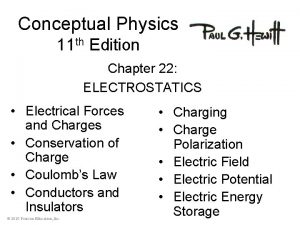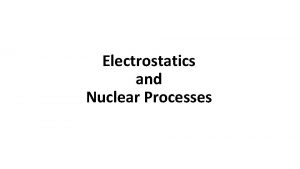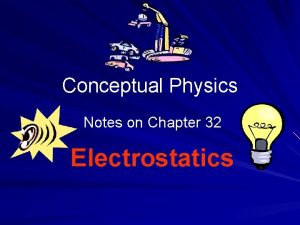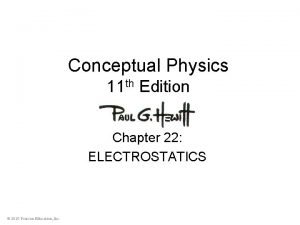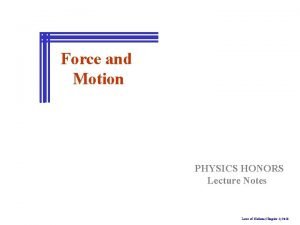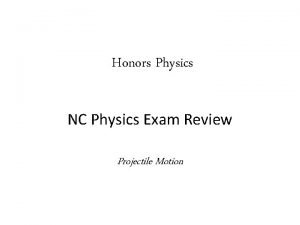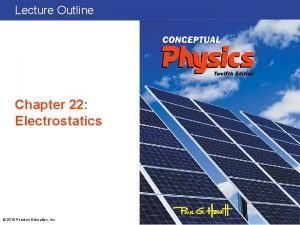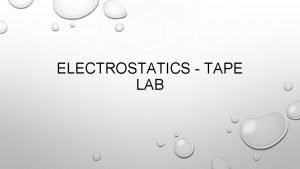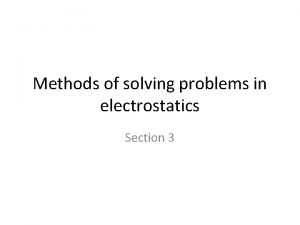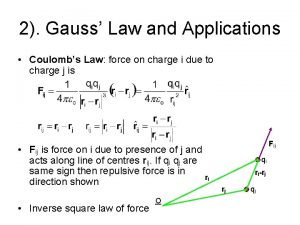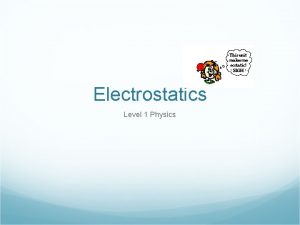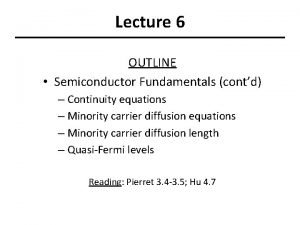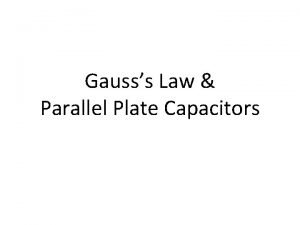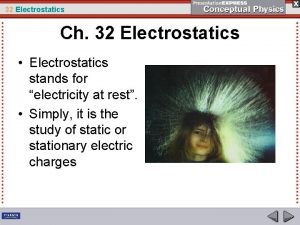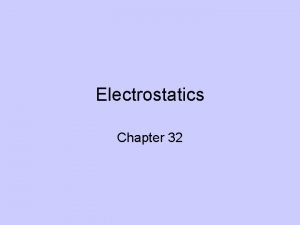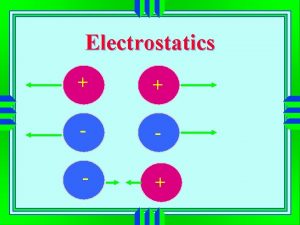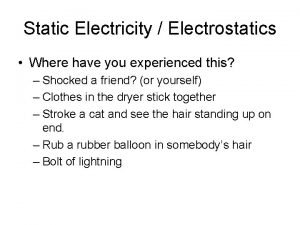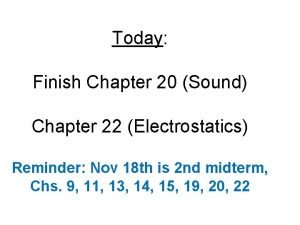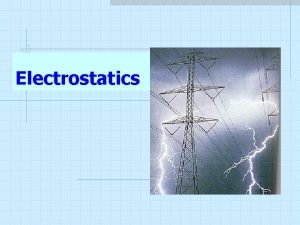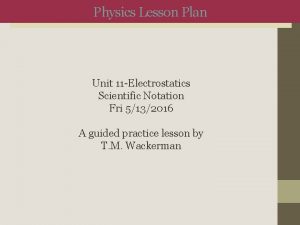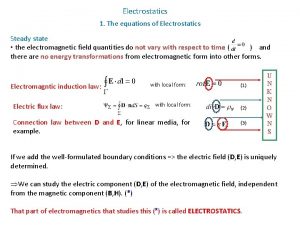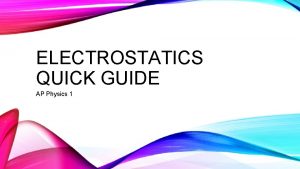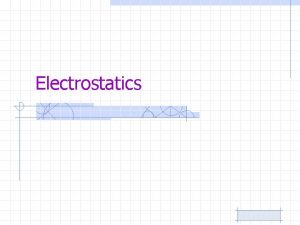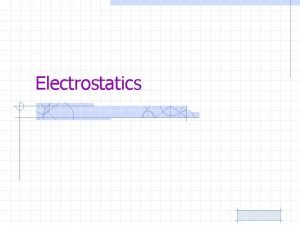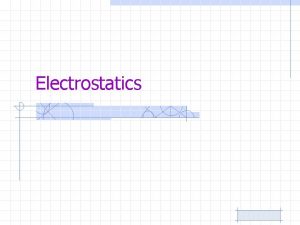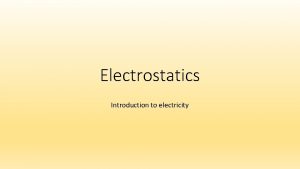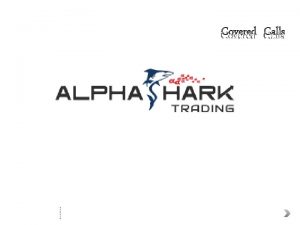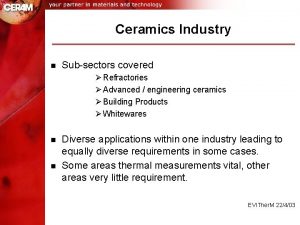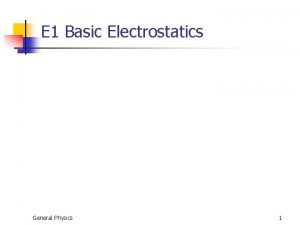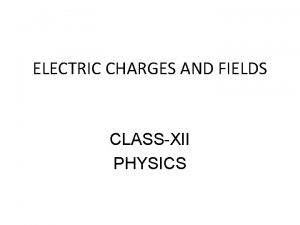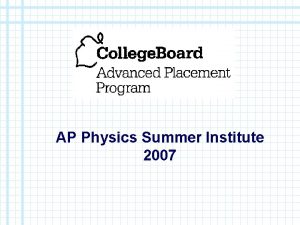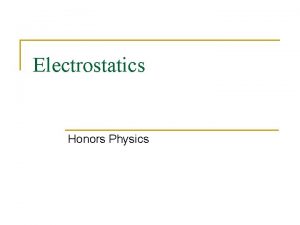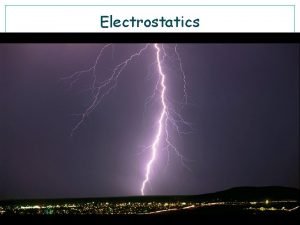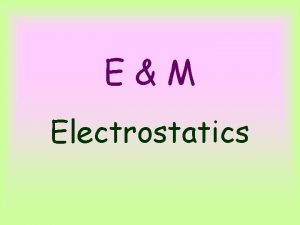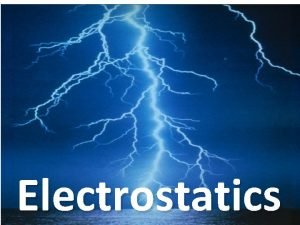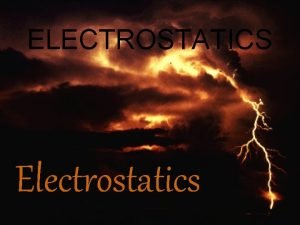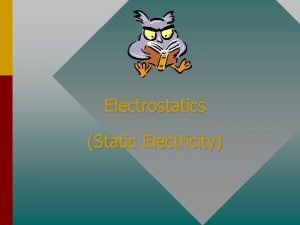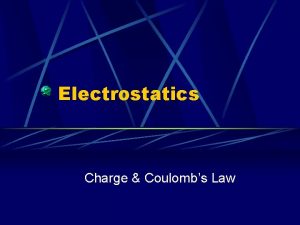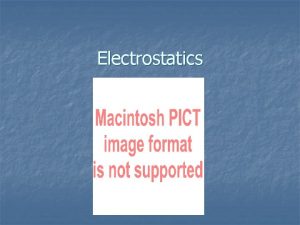Electrostatics Electrostatics Sections Covered Honors Physics Chapters 20

























- Slides: 25

Electrostatics

Electrostatics Sections Covered – Honors Physics – Chapters 20 and 21 Topics Covered – Electrical Charges – Calculating Charge – Transfer of Charge/Conservation of Charge – Insulators and Conductors – Coulomb’s Law – Lightning

What is Electric Charge? • Electric charge is a property of matter. (Same as color, density, mass, etc. . ) The Atom: Inside the Nucleus: • Proton, positively charged • Neutron, neutral, no charge Outside the Nucleus: • Electron, negatively charged

Electric Charge • *Protons – held in the nucleus *Electrons – outside of the nucleus, free to move Neutrally Charged Objects Equal numbers of protons and electrons. Positively Charged Objects Missing electrons Negatively Charged Objects Excess electrons

Elementary Charge • Elementary Charge (e) (smallest amount possible) – Charge of one proton or one electron e = +/- 1. 60 x 10 -19 C Proton e+ = + 1. 60 x 10 -19 C Electron e- = - 1. 60 x 10 -19 C SI Unit for Electrical Charge: Charles. Augustin de Coulomb (C)

Quantized • Electric charge comes in multiples of e…. . because you don’t have parts of protons or electrons 2 electrons -1. 60 x 10 -19 C Charge = 2 x -1. 60 x 10 -19 C Charge = 4. 5 x -1. 60 x 10 -19 C • Charge is quantized – comes in distinct values (quantities)

Calculating Charge • To calculate charge: q = electrical charge N = Number of protons or electrons e = elementary charge

Example 1 An object contains 5. 50 x 1014 protons and 5. 00 x 1014 electrons. What is the overall charge on this object?

Example 2 A sphere has a charge of 4. 00 C. How many electrons must be added so the charge becomes -2. 00 C?

Example 3 A metal sphere initially has a charge of -15. 0 C. What will be the net charge on the sphere if 4. 65 x 1014 electrons are also added?

Conductors and Insulators • Conductors - Substances that allow electrons to transfer easily. Examples: Copper, iron, steel, brass, gold…metals Insulators - Substances that do not allow electrons to transfer easily. Examples: Wood, plastic, glass, oil, ceramics

Is Water Conductive? • Thoughts? SURPRISE! Pure water is actually not conductive But, the minerals and other salts found in water make it a conductive substance.

How Objects Gain/Lose Charge • Three methods: 1. Charging by Contact 2. Polarization 3. Induction

Charging by Contact • For objects with different charges. Charge is transferred through contact. Charge is then distributed throughout the object.

Charging by Contact – Real Life Lightning Static shock

Conservation of Charge Electric Charge is Conserved *Similar Electric to all conservation laws charge is neither created nor destroyed, only transferred.

Polarization To separate positive charge from negative Temporarily creates an area of charge without contact STEPS: 1. Begin with something y l l a ric t c e l electrically neutral l E a r t u Ne 2. Bring a charged object 3. near. The natural charges in the object will re-align. Some attracted, some repelled.

Charging by Induction • Similar to charging by polarization *Charging by Induction results in the movement of charges but with no contact. Step 1: Begin with a neutral object Step 3: Attach a Step 2: Bring a charged object near. ground or a path of escape for Polarizes the electrons. charges inside. Step 4: Remove the ground, trapping Step 5: Final result is a positively charged

Electrostatic Induction – Real Life Uses…. Precautions Against…

Example 4 – Review Problem *There’s a reason for this, I promise Find the Fx and Fy for the forces shown.

Laws of Attraction …and Repulsion *Opposites attract (protons and electrons) *Likes repel (proton and proton, electron and electron) The closer the charges are, the stronger the force of attraction or repulsion *But how much attraction and/or repulsion is there?

Coulomb’s Law • Calculates the force of either attraction or repulsion from one charge to another. *Reminder, force is a vector MAGNITUDE: F = Force q 1 and q 2 = electrical charges r = distance between the two charges DIRECTION: k = 8. 99 x 109 constant value Opposites attract, likes repel

Example 5 The nucleus of a helium atom contains two protons that are separated by a distance of 3. 00 x 10 -15 m. A. How much force do they exert on each other? B. If each proton has a mass of 1. 67 x 10 -27 kg, and utilizing the force found in part A, what would be the acceleration of either of the protons?

Example 6 Calculate the following for the three charges shown below. A. What is the magnitude and direction of the force of q 1 on q 3? B. What is the magnitude and direction of the force of q 2 on q = +2. 00 μC q 3? C. What is the Fx and Fy on q 3? D. What is the net force on q 3? 0. 400 m 2 q 1 = +2. 00 μC 0. 300 m q 3 = +4. 00 x 10 -5 C

Example 7 Three charges (q 1, q 2, and q 3) all lie within the same plane. Calculate the net force exerted on q 2 by the other two charges. A. What is the magnitude and direction of the force between q 1 and q 2? B. What is the magnitude and direction of the force between q 3 and q 2? q 3 = +5. 00 x 10 -5 C q 2 = -2. 00 x 10 -5 C C. What is the magnitude of the net force on 2. 50 q 2 m? 1. 75 m q 1 = -6. 00 x 10 -5 C
 Conceptual physics chapter 22 electrostatics
Conceptual physics chapter 22 electrostatics Physics classroom electrostatics
Physics classroom electrostatics Chapter 32 electrostatics conceptual physics
Chapter 32 electrostatics conceptual physics Conceptual physics chapter 22
Conceptual physics chapter 22 Physics honors notes
Physics honors notes Honors physics semester 1 review
Honors physics semester 1 review Honors physics projectile motion test
Honors physics projectile motion test General physics measurement
General physics measurement Electrostatics formula
Electrostatics formula Chapter 22 electrostatics
Chapter 22 electrostatics Electrostatics sticky tape lab answers
Electrostatics sticky tape lab answers Method of inversion electrostatics
Method of inversion electrostatics Divergence of electric field
Divergence of electric field Induction charging physics
Induction charging physics Continuity equation in semiconductor
Continuity equation in semiconductor Electrostatics
Electrostatics Electrostatics
Electrostatics Type of charging processes
Type of charging processes Electricity at rest
Electricity at rest Electrostatics
Electrostatics Facts about electrostatics
Facts about electrostatics First law of electrostatics
First law of electrostatics Chapter 22 electrostatics
Chapter 22 electrostatics What is electrostatics
What is electrostatics Electrostatics lesson plan
Electrostatics lesson plan Electrostatics
Electrostatics
